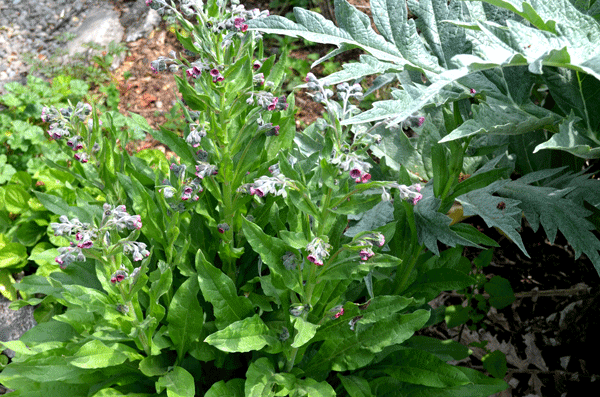 Comfrey is a noxious weed that seems to pop up everywhere on our homestead. The plant gets huge very quickly and can be difficult to pull. The long tap root usually breaks off before you can get the full plant out. But comfrey has some good qualities to offer, in moderation.
Comfrey is a noxious weed that seems to pop up everywhere on our homestead. The plant gets huge very quickly and can be difficult to pull. The long tap root usually breaks off before you can get the full plant out. But comfrey has some good qualities to offer, in moderation.
The plant has been used medicinally to heal wounds. Harvest the root, clean, let it dry, then mix with vodka. In a few weeks, you will have a tincture that you can apply to open cuts for fast healing. Don’t drink the tincture! It’s for external use only.
 Comfrey also produces beautiful pinkish-purple flowers, which look gorgeous in our garden among the other purple flowering plants like echinaea, artichoke, irises and flowering alliums. The bees love the blossoms and the plant blooms fairly continuously through the summer.
Comfrey also produces beautiful pinkish-purple flowers, which look gorgeous in our garden among the other purple flowering plants like echinaea, artichoke, irises and flowering alliums. The bees love the blossoms and the plant blooms fairly continuously through the summer.
Lemon balm is an incredibly persistent weed for us. The plant comes up vigorously and forms into a dense, huge clump in the garden. It can be extremely difficult to pull up. To remove it, I usually end up digging it out and losing a lot of soil tangled in the root ball. I smell like furniture polish by the time the ordeal is over, from the strong scent of the plant.
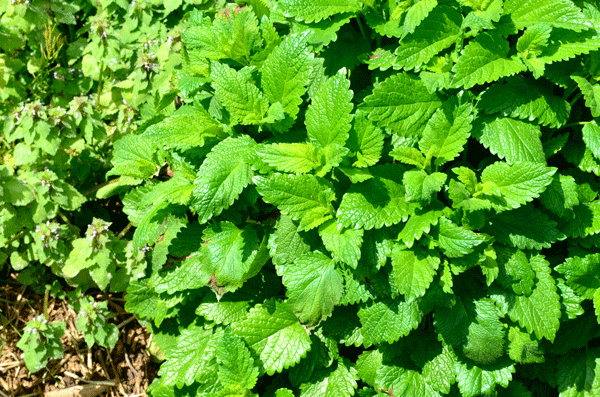 As much as I dislike having it all over my garden, the plant does have some good qualities. You can make it into a minty, citrus tea or use the leaves in cooking for fish and egg dishes. It has been used medicinally as a tea to help with depression and anxiety as well. If you want lemon balm in your garden, plant it in a pot as mints tend to be really aggressive.
As much as I dislike having it all over my garden, the plant does have some good qualities. You can make it into a minty, citrus tea or use the leaves in cooking for fish and egg dishes. It has been used medicinally as a tea to help with depression and anxiety as well. If you want lemon balm in your garden, plant it in a pot as mints tend to be really aggressive.
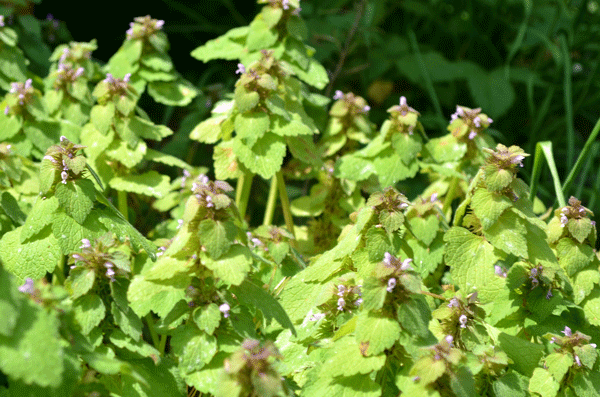 Red Deadnettle is another plant we consider a weed around here. You can pull and pull, but it pops up again whenever there is a bare patch of soil. The bees love the flowers that emerge in early spring, when food is limited, and there are certainly uglier weeds out there. Wild foragers have even started experimenting with ways to eat the plant, like HunterGatherCook. Be flattered by its presence – it usually shows up in places with excellent soil.
Red Deadnettle is another plant we consider a weed around here. You can pull and pull, but it pops up again whenever there is a bare patch of soil. The bees love the flowers that emerge in early spring, when food is limited, and there are certainly uglier weeds out there. Wild foragers have even started experimenting with ways to eat the plant, like HunterGatherCook. Be flattered by its presence – it usually shows up in places with excellent soil.
What plants do you consider weeds? Are there certain ones you tolerate while others you pull? Are you finding resourceful ways to eat or use the plants medicinally? I would love to compare notes!
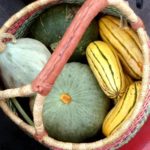
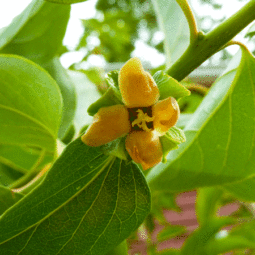

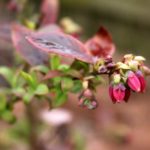

 This cluster was about the siz
This cluster was about the siz




 I start with a
I start with a


Around here we pull catnip constantly. Sometimes bring in a few leaves for the cat, but mostly we just chuck it out into the field in hopes that it won’t come back. At least it’s a nice-smelling weed, though.
Oh my goodness, I’d be so happy if I found comfrey! You don’t have to dry comfrey to make tincture–you just have to use grain alcohol instead of vodka because of the higher water content in fresh herb (vodka has about half the alcohol content of grain alcohol, which means it’s higher in water content). You can also dry it and make tea, which you shouldn’t drink too much of but some midwives recommend a cup of comfrey tea every day during pregnancy, and some have said that since they stopped recommending this because of recent warnings, they’ve seen more hemorrhage in postpartum. But completely safe and useful for anyone is to use comfrey poultices–put dried comfrey in an old sock, cover with boiling water, and place (as soon as it’s cool enough) on a sore, strained, or sprained muscle. It is also excellent for healing open wounds but make sure it’s not infected and it’s cleaned well–it’s known for it’s very powerful healing.
Also, it’s not only the root that is used–the leaves are excellent for their anti-inflammatory and astringent properties.
And that’s all I’ve got to say about comfrey! (well, maybe. We learn a lot about herbal healing in midwifery school…)
What a wonderful post. I actually buy comfrey and plant it. It’s supposed to be a good companion plant for fruit trees and other things. I read that you are supposed to cut it back and use the stalks and leaves to make mulch or you can soak them to make fertilizer tea. Its deep tap root mines minerals from deep in the soil and brings them to the surface. I recognize the red deadnettle. I have it in abundance but I never knew the name. It’s nice to hear it’s a sign of good soil. I only pull it if it is totally in the way. I’m not much on pulling weeds anyway. I just trim them back until the veggies get bigger. Then I just let things grow all together. Works fine actually.
This was such an arbitrary post to stumble upon, and I am so happy I did. I am curious to know about so many of the “weeds” in my flower beds… I only learned in the last two years that Echinacea (the flower) is THE Echinacea… maybe I was hit in the head as a kid, because it just makes sense, right?
Though comfrey sounds great… I don’t think that is what I have… it looks similar, but mine has sharp needles at the points of the leaves, and I have hated it since I was a kid on the farm. Do you know what that is?
I also noticed the deadnettle as a kid and made the connection that wherever it was there would be bees. I have plenty of fruit trees to make them happy in the spring, so I probably won’t be cultivating it soon.
Meanwhile, I have loads of the lemon balm – I did not realize it was a mint – and am super curious now about it.
Thanks for all the info, Renee.
Wonderful comments! Elizabeth and Tracy, thank you for the great info on comfrey! Kat, catnip would never get established here bc the neighbor cats would devour it. Ken, I’m not sure what the weed is in your garden. You could try emailing me a picture.